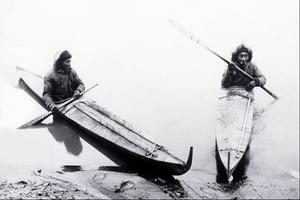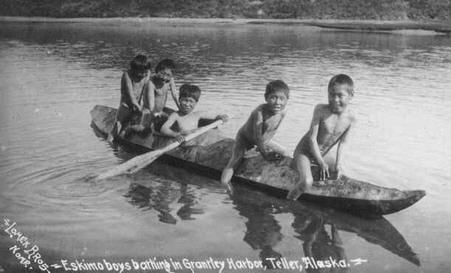Kayaks were invented in the mid-1800s and became popular with Europeans for leisure boating. In primarily German and Frenchy places boats were only used by floating on top of the water. However, around two years ago kayaks started showing up in colder areas of the world such as Scandinavia, where tribes still use them for work and recreation.
Key Takeaways
- The Inuit people developed kayaks and they used these boats for fishing and hunting along the coast of the North Atlantic, the Arctic Ocean, etc.
- Kayaks have 5000 years of legacy and you can see some of these old boats in the Museum of Ethnology in Munich Germany
“Man’s boat” or “hunter ship” is what the word kayak means. The meaning makes sense as kayaks were first developed in northern regions of the world for the purpose of hunting and traveling around. Originally, kayaks were one-person boats.
Somewhere in time, kayaks might have been specifically built by and for the hunter. His wife might have been the main craftsman, who sewed the skins to build the boat.
The earliest kayaks show that they were accustomed to the hunter’s size for maximum maneuverability. These kayaks were lightweight and were primarily used in rivers, lakes, and seas.
Fast forward to 2018, the kayak is extremely popular worldwide for both sport and recreation. Surprisingly, kayaks are now hardly used for hunting, as it was in the early days. A kayak user relies on a paddle with two blades to operate a kayak.

Two blades are located on each end of the paddle, which is useful for steering and balance.
Many people sometimes confuse a kayak with a canoe. The canoe is a different type of watercraft. However, they do look similar in some aspects. Kayaks and canoes behave in similar ways, but they have differences too. Their design is one main difference one has to note.
When Was Kayak Invented?
The Inuit people were the first ones to develop kayaks. The indigenous peoples of the Arctic region showed signs of the first development of kayaks. These residents of the Arctic relied on these boats for fishing and hunting along the coast of the North Atlantic, the Arctic Ocean, as well as the Bering Sea and the North Pacific Ocean.
Kayaks have 5000 years of legacy to boast. Old kayaks are housed in museums. You can be able to see some of these old boats in the Museum of Ethnology in Munich Germany. The kayak was the primary transport for most Inuit peoples, from the Aleutian Islands, all the way to Greenland.

These people relied on kayaks for hunting a variety of prey, such as seals, whales, bears, and caribou. Traditional kayaks, circa 1880, illustrate the way Yupik and Inupiak hunters built kayaks off the coast of Alaska in the 19th century.
Where Was The Kayak Created?
The kayak is believed to have been created by the indigenous people of what is now Greenland. It was made from seal skins and sewn together with sinew.
The kayak has gone through many changes over the years, with each era influencing its design. The first design incorporated a small deck in front of what would be the seat, and it was used for hunting and fishing on the ice floes.
The later designs had a larger body that could transport more passengers, which became popular during the European exploration period in North America.
Kayaking Today: Modern History Of Kayaks
Today many Arctic peoples almost abandoned or otherwise forgotten traditional kayak culture. Since the 1960s, fathers have no longer introduced their children to kayaking. It is an elective subject in their schools.
Around the 20th century, Europe and North America started using kayaks in different ways. They started adopting kayaks for recreational purposes. It took some time to be considered a recreational medium. Perhaps the art of building kayaks was no longer in practice or too difficult for the new generation.
A boat such as the French périssoire, which was popular from 1900 to 1960, was perhaps inspired by the kayak.
From 1970 on, the first kayaks relied on molded plastic for construction; this boat began to have racked commercial success, especially in France. Although the traditional kayak was reserved for navigation at sea, modern kayaks are manufactured and built mainly for whitewater navigation.
Kayaks, with their firm short deck, allowed navigation in previously remote rivers. By 1990, the vogue for this sport attracted many young people. On calm lakes and rivers, kayaking became appealing for beginners because it was more maneuverable.

With increased maneuverability, kayaks became lighter and cheaper than the canoe, and it allowed the solo practice.
Change Is Coming
Kayaks: The Beginning
A kayak was probably conceptualized as the initial function for hunting marine mammals. Our forefathers may have used kayaks to hunt whales, seals, and narwhals in the Arctic Circle. With the advent of technology, motorized boats soon took over kayaks and many other types of boats.
That doesn’t mean kayaks have gone obsolete. You can still spot kayaks in use in many remote Inuit colonies for fishing purposes. Besides this, kayaks can be used to carry out an expedition in lakes, rapid rivers, and open water.
Kayaks: Now
Kayaks are now mostly used for recreational purposes. They are now used for sports, such as surfing, general racing, and motor racing. To be used for recreational purposes, kayaks had to shift away from traditional design to raw materials.
Kayaks are precisely engineered for their desired function. Kayaks have been changed, modified, and modernized. Now kayaks vary from surfing to military use.
Aboriginal people started modifying their vessels after contact with Europeans. This gradually created changes in the way they used to transport. Starting around the 17th century, some Inuit began to purchase Scandinavian wood from merchants. And, with materials, they started manufacturing kayaks.
Over the centuries, kayaks began to lose variety and decoration.
The Inuit people started to use nails, nylon strings, and metal plates. Anthropologists mentioned that by 1968, some kayaks were made entirely of plywood.
Despite the acute skill of the hunters of this Ammassalik region, for instance, kayaking accidents were recurrent, and this contributed to one of the main causes of death for the men. By the 1900s, the explorer Knud Rasmussen mentioned that some tribes, in contact with the whalers since the 1860s, dumped kayaking and hunting marine mammals, to focus on whaling with up-to-date techniques.
Around 1960, the Inuit of Greenland took a keen interest in powerboats and left behind the kayaks and umiaks. Likewise, the inactive populations chose the desertion of hunting by kayak, as it was very unsafe compared to other hunting techniques such as using nets.
Spending time hunting finally dissuaded many young people from pursuit, and thus abandoned the skill of learning to kayak.
Types Of Kayaks Were Built Thousands Of Years Ago
The Inuit and Aleut tribes were ingenious in building light, efficient kayaks out of whalebones & driftwood. The Kayaks these tribes build allowed them to explore beyond the Arctic Circle. So the common types were:
1. Whalebones Kayaks
2. Driftwood Kayaks
Bottom Line
Kayaking is one of the most popular watersports in the world. Its appeal as a recreational sport is on the rise. People kayak as a way to connect with nature. Its evolution is synonymous with the development of human civilization.
References:
https://www.blazinpaddles.com/a-brief-history-of-kayaking/
https://en.wikipedia.org/wiki/Kayak
https://adventure.howstuffworks.com/outdoor-activities/water-sports/kayaking4.htm
https://www.canoeicf.com/history

Rockey is a kayaking enthusiast who has been kayaking with a local group for the last five years. He loves using kayaks while out on outings on the water or camping when the friends want to have a BBQ party somewhere on the bank of a local lake. More About James R Rockey at About Page Here: Authors
Based on his experiences with the different types of kayaks, he is sharing his opinion about kayaking tricks and required gears so that a beginner can get started right away.
Find his team on Twitter here. Happy reading!
